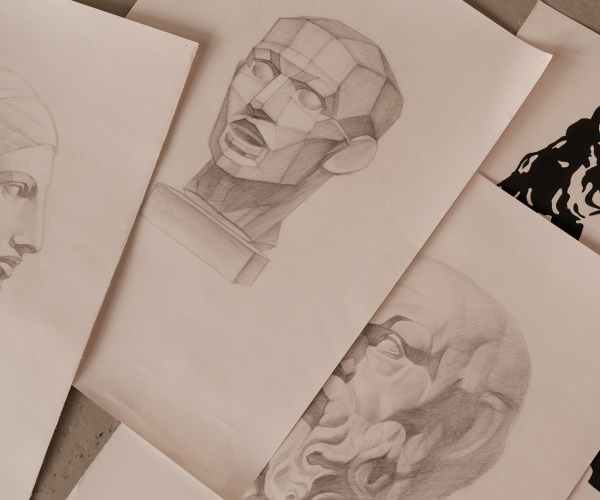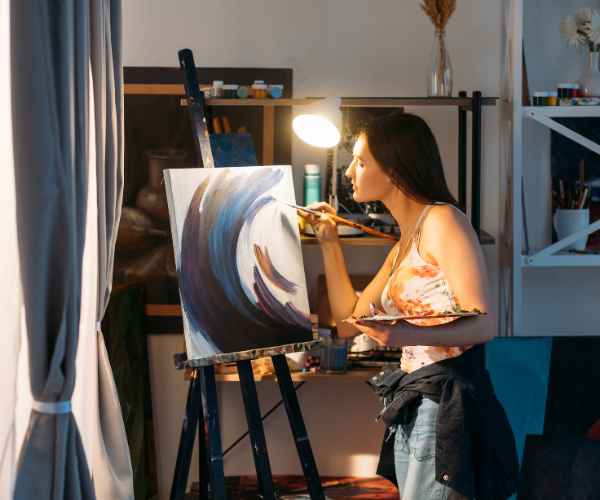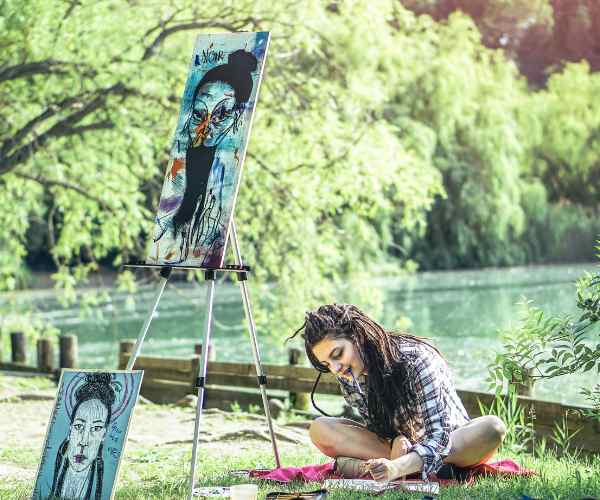When I think about the artists I admire, a common thread emerges: their work is deeply rooted in personal experiences.
Personal experiences shape our artistic expression in ways that are often profound and transformative.
It’s those little moments—the laughter shared with friends, the heartaches that leave scars, the beauty found in a sunset after a long day—that fuel our creativity.
Using personal experiences as artistic inspiration allows us to tap into a well of authenticity that resonates with others.
This post aims to explore how our unique stories can not only inspire our own work but also forge connections with those who encounter it.
Let’s dive into the magic of personal experiences and see how they can ignite our creative flames!

The Power of Personal Experiences in Art
There’s something incredibly powerful about the emotional depth that personal experiences infuse into art.
Take Vincent van Gogh, for instance.
His paintings are more than just beautiful images; they’re windows into his emotional struggles, his joys, and his pain.
When I look at Starry Night, I don’t just see swirls of blue and yellow; I feel the turbulence of his mind and the beauty he saw in chaos.
Each brushstroke tells a story, and those stories resonate with us because they reflect our own experiences.
Personal experiences create a unique voice and perspective in art, allowing us to speak from a place of truth.
When we draw from our own lives, we share not just our art but a part of ourselves, inviting others to connect with us on a deeper level.
Finding Inspiration in Everyday Life
Observe your surroundings.
Finding inspiration in everyday life is one of the most rewarding aspects of being an artist.
I remember a day when I was feeling particularly uninspired.
I decided to take a walk around my neighborhood, with no particular destination in mind.
As I strolled past familiar houses, I noticed the little things—an elderly couple tending to their garden, a child giggling while chasing bubbles, the way the sunlight filtered through the leaves of the trees.
Each moment was like a tiny gem waiting to be discovered.
I pulled out my sketchbook and started capturing these snippets of life.
What struck me was how these seemingly mundane moments held stories waiting to be told.
Encouraging you to take note of your surroundings is crucial.
Look for the beauty in the ordinary.
There’s inspiration everywhere; sometimes, we just need to pause and observe.
Reflect on Significant Life Events
On the other hand, significant life events can serve as powerful artistic inspiration.
For me, one of the most impactful experiences was losing a loved one.
The emotions that surged within me—grief, confusion, and ultimately acceptance—transformed how I approached my art.
I found myself creating pieces that expressed the rawness of loss, pieces that told stories of love and remembrance.
This brings to mind the story of Frida Kahlo.
Her art was heavily influenced by her tumultuous life experiences, including her health struggles and the pain of her tumultuous relationship with Diego Rivera.
Kahlo’s paintings, like The Two Fridas, reveal her internal struggles and the complexities of her identity.
Her ability to transform personal pain into visual narratives not only resonated with many but also paved the way for future artists to explore their own vulnerabilities.
Life events, whether joyful or heartbreaking, can shape the direction of our creative journeys.
So, don’t shy away from reflecting on those moments.
They can be the wellspring of your most powerful art.
Sure! Here’s the content for the specified sections, written as if I were Elena Martinez from Pro Creative Arts, sharing insights in a conversational and relatable manner.
Translating Personal Experiences into Art
Journaling as a Creative Tool
One of the most effective ways to translate personal experiences into art is through journaling.
I can’t stress enough how powerful this tool has been for my creative process.
Whenever I feel overwhelmed or creatively blocked, I turn to my journal.
It’s a safe space where I can explore my thoughts and feelings without judgment.
Just the act of writing things down can be incredibly cathartic.
To journal effectively for inspiration, I recommend setting aside a few minutes each day to write.
Start with whatever comes to mind—don’t worry about grammar or structure.
Allow your thoughts to flow freely.
Sometimes, it helps to use prompts, like “What made me feel alive today?” or “What’s a moment I wish I could relive?”
These questions can ignite memories and emotions that you might want to explore in your art.
Don’t hesitate to include sketches or doodles alongside your writing.
Visual elements can enhance the storytelling aspect and may even spark ideas for your next piece.
Experimenting with Different Mediums
Another exciting way to translate personal experiences into art is by experimenting with different mediums.
As artists, we often find that certain materials resonate with specific emotions or stories we want to convey.
For instance, when I was going through a particularly challenging time, I initially expressed my feelings through painting.
But then I stumbled upon collage.
Cutting out images and words from magazines and layering them felt liberating.
I could combine various elements of my experience—words, textures, colors—into one cohesive piece that reflected my emotional state more accurately than paint alone could.
A great example of an artist who embraced different mediums is David Hockney.
He started with traditional painting and eventually moved to digital art, creating stunning iPad drawings that captured the beauty of everyday life.
His willingness to experiment has allowed him to convey his experiences in innovative ways, keeping his work fresh and relatable.
The Role of Vulnerability in Art
Embracing vulnerability is one of the most potent tools in an artist’s arsenal.
When we allow ourselves to be vulnerable, we tap into the raw emotions that connect us with others.
It’s this honesty that makes art resonate.
Take Frida Kahlo, for example.
Her self-portraits are deeply personal, reflecting her physical and emotional pain.
In The Broken Column, you can see her vulnerability laid bare; she portrays herself with the spine of a shattered column, exposing her inner struggles.
Her willingness to share her pain not only invites the audience into her world but also allows them to confront their own experiences and emotions.
Kahlo’s art serves as a reminder that vulnerability can lead to profound connections, both with our work and our audience.
Creating Art That Resonates
Telling Your Story
When it comes to creating art that resonates, authenticity is key.
Your story is unique, and it’s essential to communicate that authenticity through your work.
Start by identifying the core message or emotion you want to express.
Ask yourself what your experiences mean to you and how they have shaped who you are today.
To communicate personal stories effectively, consider using symbolism.
For instance, if your work reflects themes of growth, you might incorporate images of trees or flowers to symbolize that journey.
I often remind myself to think about how my story can evoke emotions in others.
The more genuine and relatable your work is, the more likely it will resonate with viewers.
Engaging Your Audience
Relatable personal experiences have a remarkable way of creating a strong bond with viewers.
When people see themselves in your art, it becomes a shared experience, something they can connect to on a deeper level.
I remember a local artist who created a series of paintings about family gatherings.
Each piece captured candid moments—the laughter, the shared meals, the quiet conversations.
These paintings struck a chord with many in our community because they reminded us of our own family experiences.
Art can be a powerful vessel for storytelling, and when it reflects shared experiences, it can move audiences in ways we might not expect.
FAQs
Q1: How can I start using my personal experiences in my art?
A1: That’s a fantastic question!
The best place to start is by taking a moment to reflect on your life experiences.
Think about the significant events that have shaped who you are today—both the good and the bad.
I often suggest keeping a journal where you can jot down your thoughts and feelings.
It doesn’t have to be anything formal or polished.
Just write!
You might be surprised at how quickly memories and emotions come flooding back when you give yourself the space to explore them.
Once you have some ideas, you can start brainstorming how those experiences can translate into your art.
Maybe a particular moment from your past inspires a painting, a poem, or even a piece of music.
The key is to be open and allow your emotions to guide your creative process.
Q2: What if my experiences are too personal to share?
A2: I completely understand that concern.
Some experiences can feel too raw or vulnerable to put out into the world, and that’s perfectly okay.
Instead of directly sharing your story, you might consider creating abstract representations of your feelings.
Think about using colors, shapes, or symbols that represent your emotions rather than detailing the events themselves.
For instance, if you’ve gone through a heartbreak, you might use dark, jagged lines and cooler colors to express that pain without being explicit about the situation.
This approach allows you to maintain your privacy while still conveying the depth of your feelings.
Art is about exploration, and sometimes it’s more about the journey than the destination.
Q3: Can using personal experiences limit my artistic creativity?
A3: Not at all!
In fact, personal experiences can serve as a powerful springboard for broader themes and explorations.
When you tap into your own life, you might find that your unique voice resonates with universal feelings that many others can relate to.
Think about artists like Van Gogh or Frida Kahlo.
They didn’t just share their personal experiences; they created art that speaks to deeper human emotions, such as love, loss, and identity.
Using your experiences as a foundation can help you branch out into new ideas and narratives that might not have surfaced otherwise.
Embrace your story, but don’t feel constrained by it.
Your personal history is just one part of your artistic journey!
Conclusion
As we wrap up our exploration of using personal experiences as artistic inspiration, it’s clear that these experiences hold immense potential for creativity.
By reflecting on your life events, you can uncover rich emotions and stories waiting to be told.
Remember, it’s not just about the events themselves but how they’ve shaped you and how you can communicate those feelings through your art.
I encourage you to embrace your stories, however personal they may be, and find ways to express them creatively.
Art has an incredible ability to connect us, and sharing your journey can resonate with others in profound ways.
I’d love to hear about your experiences and how they’ve influenced your artistic path.
Feel free to share your thoughts and stories in the comments below!
Let’s keep the conversation going and inspire each other to create meaningful art!





